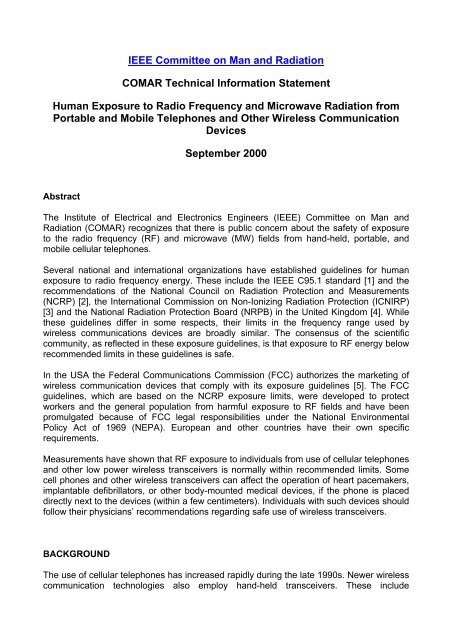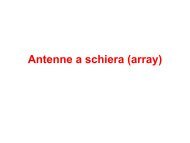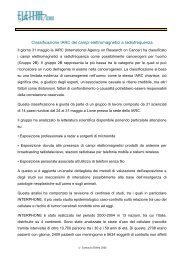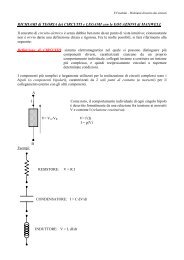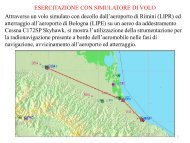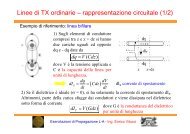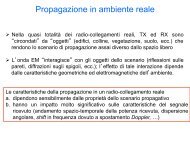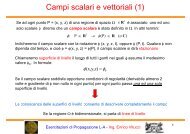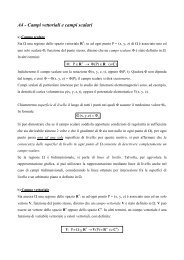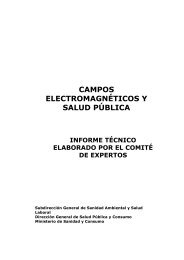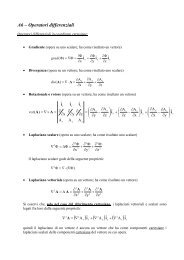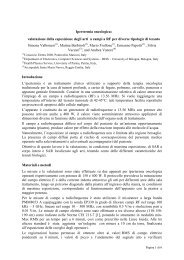IEEE Committee on Man and Radiation - Consorzio Elettra 2000
IEEE Committee on Man and Radiation - Consorzio Elettra 2000
IEEE Committee on Man and Radiation - Consorzio Elettra 2000
Create successful ePaper yourself
Turn your PDF publications into a flip-book with our unique Google optimized e-Paper software.
<str<strong>on</strong>g>IEEE</str<strong>on</strong>g> <str<strong>on</strong>g>Committee</str<strong>on</strong>g> <strong>on</strong> <strong>Man</strong> <strong>and</strong> Radiati<strong>on</strong>COMAR Technical Informati<strong>on</strong> StatementHuman Exposure to Radio Frequency <strong>and</strong> Microwave Radiati<strong>on</strong> fromPortable <strong>and</strong> Mobile Teleph<strong>on</strong>es <strong>and</strong> Other Wireless Communicati<strong>on</strong>DevicesSeptember <strong>2000</strong>AbstractThe Institute of Electrical <strong>and</strong> Electr<strong>on</strong>ics Engineers (<str<strong>on</strong>g>IEEE</str<strong>on</strong>g>) <str<strong>on</strong>g>Committee</str<strong>on</strong>g> <strong>on</strong> <strong>Man</strong> <strong>and</strong>Radiati<strong>on</strong> (COMAR) recognizes that there is public c<strong>on</strong>cern about the safety of exposureto the radio frequency (RF) <strong>and</strong> microwave (MW) fields from h<strong>and</strong>-held, portable, <strong>and</strong>mobile cellular teleph<strong>on</strong>es.Several nati<strong>on</strong>al <strong>and</strong> internati<strong>on</strong>al organizati<strong>on</strong>s have established guidelines for humanexposure to radio frequency energy. These include the <str<strong>on</strong>g>IEEE</str<strong>on</strong>g> C95.1 st<strong>and</strong>ard [1] <strong>and</strong> therecommendati<strong>on</strong>s of the Nati<strong>on</strong>al Council <strong>on</strong> Radiati<strong>on</strong> Protecti<strong>on</strong> <strong>and</strong> Measurements(NCRP) [2], the Internati<strong>on</strong>al Commissi<strong>on</strong> <strong>on</strong> N<strong>on</strong>-I<strong>on</strong>izing Radiati<strong>on</strong> Protecti<strong>on</strong> (ICNIRP)[3] <strong>and</strong> the Nati<strong>on</strong>al Radiati<strong>on</strong> Protecti<strong>on</strong> Board (NRPB) in the United Kingdom [4]. Whilethese guidelines differ in some respects, their limits in the frequency range used bywireless communicati<strong>on</strong>s devices are broadly similar. The c<strong>on</strong>sensus of the scientificcommunity, as reflected in these exposure guidelines, is that exposure to RF energy belowrecommended limits in these guidelines is safe.In the USA the Federal Communicati<strong>on</strong>s Commissi<strong>on</strong> (FCC) authorizes the marketing ofwireless communicati<strong>on</strong> devices that comply with its exposure guidelines [5]. The FCCguidelines, which are based <strong>on</strong> the NCRP exposure limits, were developed to protectworkers <strong>and</strong> the general populati<strong>on</strong> from harmful exposure to RF fields <strong>and</strong> have beenpromulgated because of FCC legal resp<strong>on</strong>sibilities under the Nati<strong>on</strong>al Envir<strong>on</strong>mentalPolicy Act of 1969 (NEPA). European <strong>and</strong> other countries have their own specificrequirements.Measurements have shown that RF exposure to individuals from use of cellular teleph<strong>on</strong>es<strong>and</strong> other low power wireless transceivers is normally within recommended limits. Somecell ph<strong>on</strong>es <strong>and</strong> other wireless transceivers can affect the operati<strong>on</strong> of heart pacemakers,implantable defibrillators, or other body-mounted medical devices, if the ph<strong>on</strong>e is placeddirectly next to the devices (within a few centimeters). Individuals with such devices shouldfollow their physicians’ recommendati<strong>on</strong>s regarding safe use of wireless transceivers.BACKGROUNDThe use of cellular teleph<strong>on</strong>es has increased rapidly during the late 1990s. Newer wirelesscommunicati<strong>on</strong> technologies also employ h<strong>and</strong>-held transceivers. These include
specialized mobile radio (SMR) <strong>and</strong> pers<strong>on</strong>al communicati<strong>on</strong>s services (PCS) (which arealso cellular wireless systems). Currently there are over 80 milli<strong>on</strong> cellular ph<strong>on</strong>e users inthe United States <strong>and</strong> its territories <strong>and</strong> possessi<strong>on</strong>s. The number of cellular ph<strong>on</strong>e usersworld-wide is estimated to reach 500 milli<strong>on</strong> by the year 2001 <strong>and</strong> 700 milli<strong>on</strong> by the year2003.This report addresses the c<strong>on</strong>cerns that have been expressed by some members of thepublic about the safety of exposure to radio frequency (RF) radiati<strong>on</strong> from h<strong>and</strong>heldcommunicati<strong>on</strong>s devices, with particular reference to cellular teleph<strong>on</strong>e h<strong>and</strong>sets.When c<strong>on</strong>sidering possible hazards from exposure to wireless transmitters, severalc<strong>on</strong>siderati<strong>on</strong>s must be taken into account. The first c<strong>on</strong>siderati<strong>on</strong> is frequency becauseexposure guidelines vary with frequency. Wireless communicati<strong>on</strong>s operate in a variety offrequency ranges. In the USA, h<strong>and</strong>-held <strong>and</strong> mobile cellular teleph<strong>on</strong>es operate atfrequencies between 824 <strong>and</strong> 849 MHz , while digital pers<strong>on</strong>al communicati<strong>on</strong> systems(PCS) operate in the 1850-1990 MHz b<strong>and</strong>. Portable transceivers (such as "walkietalkies")used for two-way communicati<strong>on</strong> typically operate near 30, 150 <strong>and</strong> 450 MHz.Cordless teleph<strong>on</strong>e units typically operate near 50, 915, or 2450 MHz.A sec<strong>on</strong>d c<strong>on</strong>siderati<strong>on</strong> is the power output of the transmitter, <strong>and</strong> its distance from thebody. H<strong>and</strong>-held units (either cellular ph<strong>on</strong>es or other communicati<strong>on</strong>s h<strong>and</strong>sets) operateat comparatively low power levels but are used very close to the body. Mobile unitsoperate at higher power levels, but their transmitting antennas are located some distancefrom their users.A pers<strong>on</strong>'s exposure to RF energy can be measured in several ways. For assessingexposure from transmitters located near the body, the most useful quantity is the specificabsorpti<strong>on</strong> rate (SAR). SAR is a measure of the power absorbed in the body (either in alocalized regi<strong>on</strong> of tissue or averaged over the whole body), expressed in units of wattsper kilogram of tissue. The various exposure st<strong>and</strong>ards cited above are designed to limitthe SAR in the body to safe levels.RF Safety St<strong>and</strong>ards <strong>and</strong> GuidelinesA number of organizati<strong>on</strong>s have established limits for human exposure to RF fields. Theseinclude the <str<strong>on</strong>g>IEEE</str<strong>on</strong>g> [1], the NCRP [2], the ICNIRP [3], <strong>and</strong> the United Kingdom Nati<strong>on</strong>alRadiati<strong>on</strong> Protecti<strong>on</strong> Board (NRPB) [4]. (A table of acr<strong>on</strong>yms <strong>and</strong> definiti<strong>on</strong>s is in theAppendix.) There are, in additi<strong>on</strong>, various governmental limits that are usually based <strong>on</strong>these st<strong>and</strong>ards. The different st<strong>and</strong>ards vary somewhat in their exposure limits <strong>and</strong> inother particulars. However, at frequencies used for wireless communicati<strong>on</strong>s systems,these different guidelines are broadly similar.Most of these guidelines specify two sets of limits, typically for occupati<strong>on</strong>al <strong>and</strong> n<strong>on</strong>occupati<strong>on</strong>al(general public) exposures. The <str<strong>on</strong>g>IEEE</str<strong>on</strong>g>-C95.1-1991 st<strong>and</strong>ard [1] distinguishesinstead between "c<strong>on</strong>trolled" envir<strong>on</strong>ments (any locati<strong>on</strong> where people are aware of apotential exposure) <strong>and</strong> "unc<strong>on</strong>trolled" envir<strong>on</strong>ments. Most of these st<strong>and</strong>ards have limitsfor power density that are five times higher for c<strong>on</strong>trolled envir<strong>on</strong>ments (or occupati<strong>on</strong>alexposure) than for unc<strong>on</strong>trolled envir<strong>on</strong>ments (or for the general public) at frequencies upto 3,000 MHz.
All of these st<strong>and</strong>ards include provisi<strong>on</strong>s for different exposure situati<strong>on</strong>s. These includelimits for whole-body exposure or partial body exposure (which is more relevant to users ofwireless communicati<strong>on</strong>s). The st<strong>and</strong>ards also require that the exposure be averaged overtime periods ranging from 6-30 minutes [1] (which means that incidental exposures shorterthan the averaging time can be higher than the limits). In additi<strong>on</strong>, the <str<strong>on</strong>g>IEEE</str<strong>on</strong>g> st<strong>and</strong>ard has a"low power exclusi<strong>on</strong>" that exempts low-powered devices from the necessity for exposuretesting. (Most h<strong>and</strong>-held transceivers, including cellular h<strong>and</strong>sets, fall within thisexclusi<strong>on</strong>.) Other guidelines (such as ICNIRP guidelines [3] <strong>and</strong> FCC guidelines) do notinclude such an exclusi<strong>on</strong>.All of these st<strong>and</strong>ards were developed by committees of scientists <strong>and</strong> engineers, whoexamined the scientific literature to identify potential hazards of RF exposure. Majorst<strong>and</strong>ards were based <strong>on</strong> a comprehensive review of several thous<strong>and</strong> scientific papers,including engineering studies, whole-animal <strong>and</strong> cellular studies, <strong>and</strong> human(epidemiological) studies. The st<strong>and</strong>ards were approved <strong>on</strong>ly after a l<strong>on</strong>g review processinvolving a range of stakeholders including in many cases the general public.Following their reviews of the scientific literature, most committees c<strong>on</strong>cluded that themost sensitive reproducible effect is the disrupti<strong>on</strong> of learned behavior in trained laboratoryanimals. This effect, which has been observed in several species of animals <strong>and</strong> undervarious RF exposure c<strong>on</strong>diti<strong>on</strong>s, occurs at a whole-body SAR of about 4 W/kg. This RFenergy absorpti<strong>on</strong> rate, which is associated with an increase in body temperature,stimulates the animal to stop performing a complex learned task. Such behavioral changeis reversible <strong>and</strong> not c<strong>on</strong>sidered harmful to the animal. The assumpti<strong>on</strong> is made, althoughnot yet tested, that exposures at this level (same whole body SAR) would havecomparable effects in humans. At c<strong>on</strong>siderably higher levels of exposure, thermal stresscan occur that is similar to that produced by excessively hot envir<strong>on</strong>ments or strenuousexercise.Despite a c<strong>on</strong>siderable amount of speculati<strong>on</strong> in the scientific literature, nomechanism has been established by which electromagnetic fields at levels belowrecommended limits can produce biological damage of clinical c<strong>on</strong>sequence[6].Only limited data are available about human exposures to RF energy, particularly l<strong>on</strong>gtermexposures. There have been a few studies involving the exposure of human subjectsto RF energy similar to that emitted by cell ph<strong>on</strong>es, but no c<strong>on</strong>vincing evidence hasemerged to indicate the potential for hazardous effects. An excellent review of theliterature in this area has been given by Moulder et al. [7].Two epidemiology studies have been published that bear <strong>on</strong> the questi<strong>on</strong> of a possible riskof brain cancer from the use of cell ph<strong>on</strong>es. Rothman <strong>and</strong> co-workers [8,9] have reportedno differences in mortality between the users of h<strong>and</strong>-held portable ph<strong>on</strong>es (where theantenna is placed close to the head) <strong>and</strong> mobile cellular ph<strong>on</strong>es (where the antenna ismounted <strong>on</strong> the vehicle). Hardell et al [10,11], in a study of several hundred Swedish braintumor patients, found no statistically significant associati<strong>on</strong>s between use of cell ph<strong>on</strong>es<strong>and</strong> brain cancer. It should be noted, however, that brain tumors (<strong>and</strong> other cancers) takemany years to develop, far l<strong>on</strong>ger than the durati<strong>on</strong> of exposure of most the subjects inthese studies.In summary, there is no evidence, from laboratory or epidemiology studies, that exposureto RF energy at levels below recommended limits has any health significance for humans.
Exposures Produced by Cellular Teleph<strong>on</strong>esCellular teleph<strong>on</strong>es used in the U.S. are required to operate within FCC guidelines. Thosesold in Europe may have to comply with local guidelines, which in many countries aresimilar in nature but less restrictive than those of the FCC. Compliance is verified byexperimental <strong>and</strong>/or theoretical assessment of the SARs produced by the ph<strong>on</strong>es inmodels of the head of the user. Because of the large safety factor incorporated into thest<strong>and</strong>ards, the regulatory limits are far below the anticipated thresholds for hazards.<strong>Man</strong>ufacturers in general design cellular ph<strong>on</strong>es that comply with regulatory limits,although at least <strong>on</strong>e manufacturer has had to recall cellular ph<strong>on</strong>es because operatingpower levels were slightly higher than authorized <strong>and</strong> SAR levels were somewhat inexcess of specified limits. Newer digital ph<strong>on</strong>es operate at lower average power levelsthan the older analog units, <strong>and</strong> are much less likely to exceed the exposure guidelines.Cordless teleph<strong>on</strong>es operating at 46 MHz use lower power levels than cell ph<strong>on</strong>es, <strong>and</strong>produce much less exposure to the user. However, newer cordless ph<strong>on</strong>es that operate at900 MHz <strong>and</strong> 2.45 GHz use power levels that are comparable to c<strong>on</strong>venti<strong>on</strong>al cell ph<strong>on</strong>es.Interference to Medical DevicesSufficiently high levels of RF energy can interfere with other electr<strong>on</strong>ic equipment [12].This problem is more likely to occur with pulsed energy, which characterizes digital cellularteleph<strong>on</strong>es. Studies have shown that h<strong>and</strong>held cellular ph<strong>on</strong>es can affect the operati<strong>on</strong> ofheart pacemakers or defibrillators if the ph<strong>on</strong>e is placed directly over the device [12,13],<strong>and</strong> there have been reports of interference between cell ph<strong>on</strong>es <strong>and</strong> hearing aids.Individuals with pacemakers, implantable defibrillators, or other body-mounted medicalelectr<strong>on</strong>ic devices, should c<strong>on</strong>sult with their physician <strong>and</strong>/or the ph<strong>on</strong>e manufacturer todetermine what precauti<strong>on</strong>s, if any, should be taken. Some manufacturers recommendthat cell ph<strong>on</strong>es be used <strong>on</strong> the other side of the body from the implanted pacemaker.C<strong>on</strong>clusi<strong>on</strong>sEngineering data indicate that local SARs produced by h<strong>and</strong>-held, transportable, <strong>and</strong>mobile transceivers <strong>and</strong> cellular teleph<strong>on</strong>es normally do not exceed FCC <strong>and</strong> other safetylimits. Present scientific evidence, as reviewed by st<strong>and</strong>ards setting organizati<strong>on</strong>s <strong>and</strong>other expert groups, does not dem<strong>on</strong>strate health or safety risks from cellular <strong>and</strong> othercommunicati<strong>on</strong>s transceivers. A potential exists for interference between h<strong>and</strong>-held units<strong>and</strong> some medical devices that may be located in close proximity to them (within a fewcentimeters).
APPENDICESFREQUENCIES AND OPERATING PROTOCOLS OF CELLULAR WIRELESSCOMMUNICATION SYSTEMSThe early cellular networks used an analog transmissi<strong>on</strong> protocol (called frequencydivisi<strong>on</strong>multiple access - FDMA), in which speech frequency modulates a c<strong>on</strong>tinuouswave carrier. In the USA these cellular systems operate in the 824 - 894 MHz frequencyrange (824-849 MHz for the mobile/h<strong>and</strong>-helds <strong>and</strong> 869-894 MHz for the base stati<strong>on</strong>s),which was formerly allocated to UHF televisi<strong>on</strong> channels 69-84.At the beginning of the 1990s these systems were reaching the limits of their capacity inmany service areas. This led to the introducti<strong>on</strong> of new classes of cellular service usingdigital techniques, such as time-divisi<strong>on</strong> multiple-access (TDMA), hybrid TDMA/FDMA,<strong>and</strong> more recently code-divisi<strong>on</strong> multiple-access (CDMA). These digital systems operate inthe same frequency b<strong>and</strong> as the analog systems, but provide more voice channels perradio channel. In Europe, the most comm<strong>on</strong>ly used cellular system is called GSM (GlobalSystem for Mobile Communicati<strong>on</strong>), which is a hybrid TDMA/FDMA system, <strong>and</strong> operatesin the 935-960 frequency b<strong>and</strong>.Pers<strong>on</strong>al Communicati<strong>on</strong> Services (PCS) is a newer wireless technology that operates inthe 1800-<strong>2000</strong> MHz b<strong>and</strong>, using both TDMA <strong>and</strong> CDMA technologies. Compared withanalog cellular systems, PCS systems operate at lower power levels, with more closelyspaced cells <strong>and</strong> lower power h<strong>and</strong>sets.In the USA, the Federal Communicati<strong>on</strong>s Commissi<strong>on</strong> originally authorized up to twocellular service providers per service area. However, to promote competiti<strong>on</strong>, newfrequency b<strong>and</strong>s have been created, <strong>and</strong> new services are being introduced. Theseinclude specialized mobile radio (SMR) <strong>and</strong> enhanced specialized radio (ESMR), whichoperate at frequencies just below those used for cellular service. In additi<strong>on</strong>, two PCScarriers are also licensed to operate in many regi<strong>on</strong>s of the United States.Offsetting the increased number of wireless carriers, the progressi<strong>on</strong> of cellular technologyfrom analog to digital systems with improved performance, has lead to a steady reducti<strong>on</strong>of base stati<strong>on</strong> <strong>and</strong> ph<strong>on</strong>e transmitter powers. Additi<strong>on</strong>ally, modern systems are designedto reduce the power of both the base stati<strong>on</strong> <strong>and</strong> h<strong>and</strong>set when the user is close to a basestati<strong>on</strong>, which further reduces average power levels.For additi<strong>on</strong>al informati<strong>on</strong> about wireless teleph<strong>on</strong>e systems, readers are referred todiscussi<strong>on</strong>s by Millingt<strong>on</strong> [14] <strong>and</strong> Rappaport [15].GLOSSARY <strong>and</strong> ACRONYMSANSI - American Nati<strong>on</strong>al St<strong>and</strong>ards Institute
EPA - (USA) Envir<strong>on</strong>mental Protecti<strong>on</strong> AgencyFDA - (USA) Food <strong>and</strong> Drug Administrati<strong>on</strong>ICNIRP - Internati<strong>on</strong>al Commissi<strong>on</strong> <strong>on</strong> N<strong>on</strong>-I<strong>on</strong>izing Radiati<strong>on</strong> Protecti<strong>on</strong><str<strong>on</strong>g>IEEE</str<strong>on</strong>g> - The Institute of Electrical <strong>and</strong> Electr<strong>on</strong>ics EngineersNCRP - Nati<strong>on</strong>al Council <strong>on</strong> Radiati<strong>on</strong> Protecti<strong>on</strong> <strong>and</strong> MeasurementsNIOSH - (USA) Nati<strong>on</strong>al Institute for Occupati<strong>on</strong>al Safety <strong>and</strong> HealthNRPB - Nati<strong>on</strong>al Radiati<strong>on</strong> Protecti<strong>on</strong> Board (United Kingdom)OSHA - (USA) Occupati<strong>on</strong>al Safety <strong>and</strong> Health Administrati<strong>on</strong>Analog Communicati<strong>on</strong>s Channel - A communicati<strong>on</strong> channel in which the message beingtransmitted, for example voice, directly modulates the amplitude or frequency of a higherfrequency RF or MW signal.CDMA (Code Divisi<strong>on</strong> Multiple Access) - A method of coding the digitized messages ofseveral users <strong>and</strong> transmitting them at the same time using a single communicati<strong>on</strong>channel. Each user's message is decoded independently of the others.Cellular Ph<strong>on</strong>e System - A system for mobile wireless communicati<strong>on</strong> where blocks offrequencies (channels) can be reused by dividing a geographical area into hexag<strong>on</strong>al"cells" each of which c<strong>on</strong>tains a transmit/receive base stati<strong>on</strong> antenna. A mobile userwithin a cell communicates with the base stati<strong>on</strong> in that cell or an adjacent cell depending<strong>on</strong> the strength of the received signals. As the usermoves from cell to cell, the c<strong>on</strong>necti<strong>on</strong>between the user <strong>and</strong> network is maintained by "h<strong>and</strong>ing-off" the user from <strong>on</strong>e basestati<strong>on</strong> to another, i.e., switching to a channel assigned to that base stati<strong>on</strong>.Digital Communicati<strong>on</strong> Channel - A communicati<strong>on</strong> channel in which the message isencoded as a series of "<strong>on</strong>es" <strong>and</strong> "zeros" (binary code). This can be d<strong>on</strong>e in severalways, but a comm<strong>on</strong> scheme has the phase of a comp<strong>on</strong>ent of the transmitted signalswitched in discrete steps to represent the "zeros" <strong>and</strong> "<strong>on</strong>es," respectively.Directi<strong>on</strong>al Antenna - An antenna that radiates energy efficiently in a specific directi<strong>on</strong>. Forexample, the energy from directi<strong>on</strong>al antennas used for pers<strong>on</strong>al wireless service, oftencalled "high-gain," "panel," or "sector" antennas, is usually propagated in a relativelynarrow beam in the vertical plane (of the order of 10 degrees) <strong>and</strong> typically 120 degrees inthe horiz<strong>on</strong>tal plane.Downlink - The communicati<strong>on</strong> c<strong>on</strong>necti<strong>on</strong> (transmitted signal) from a base stati<strong>on</strong> to amobile stati<strong>on</strong>.ERP (Effective Radiated Power) - A measure of how well an antenna c<strong>on</strong>centrates theradiated energy in a specific directi<strong>on</strong>. An analogy can be drawn in a comparis<strong>on</strong> betweenan ordinary light bulb <strong>and</strong> a spotlight. At a given distance, the light that falls <strong>on</strong> a surface inthe beam of a 100 W spotlight is much brighter than that from an ordinary 100 W bulb atthe same distance, because the spotlight c<strong>on</strong>centrates the light into a beam.
Corresp<strong>on</strong>dingly, the light that falls <strong>on</strong> a surface that is not in the beam of the spotlight ismuch less than that from the ordinary light bulb at the same distance.FDMA (Frequency Divisi<strong>on</strong> Multiple Access) - A method for carrying multiple messagesduring a RF or MW transmissi<strong>on</strong> by encoding the messages of different users asmodulati<strong>on</strong>s of different carrier frequencies.GSM (Global System for Mobile Communicati<strong>on</strong>s) - A hybrid TDMA/CDMA scheme widelyused throughout Europe, <strong>and</strong> also becoming available in The USA.High-Gain Antenna - an antenna whose radiati<strong>on</strong> pattern is c<strong>on</strong>centrated in a more or lessnarrow beam, i.e. a "directi<strong>on</strong>al antenna".Microwatt (µW) - a power of <strong>on</strong>e milli<strong>on</strong>th of a watt.Microwave (MW) - An electromagnetic wave with a wavelength between about <strong>on</strong>emillimeter <strong>and</strong> 30 centimeters corresp<strong>on</strong>ding to a frequency between 300 GHz <strong>and</strong> 1 GHz.Milliwatt (mW) - a power of <strong>on</strong>e thous<strong>and</strong>th of a watt.Omni-Directi<strong>on</strong>al Antenna - An antenna that radiates energy power more or less uniformlyover an angle of 360 degrees in the horiz<strong>on</strong>tal plane around the antenna. Sometimescalled a "low-gain" antenna. The familiar "whip" antennas are omnidirecti<strong>on</strong>al in theirradiati<strong>on</strong> patterns.PCS (Pers<strong>on</strong>al Communicati<strong>on</strong> Service) - A term used by cellular service providers fordigital service primarily in the 1800 - <strong>2000</strong> MHz frequency b<strong>and</strong>. The term distinguishesthis newer wireless protocol from cellular service at lower frequencies.Power Flux - sometimes called "power density," is a measure of the radiated powerreaching unit area of a surface. The accepted unit for this parameter is watts per squaremeter (W/m-sq). However, the older measure milliwatts per square centimeter (mW/cm-sq)is still encountered. 1 mW/cm-sq is equivalent to 10 W/m-sq.Radio Frequency (RF) - frequencies of electromagnetic waves between approximately 3kHz (3,000 Hz) <strong>and</strong> 300 GHz (3 x 10 11 Hz). Sometimes, a distincti<strong>on</strong> is drawn betweenradio waves, which have frequencies between 3 kHz <strong>and</strong> 1 GHz, <strong>and</strong> microwaves, whichhave a frequency between 1 GHz <strong>and</strong> 300 GHz.SAR (Specific Absorpti<strong>on</strong> Rate) - A measure of the rate at which electromagnetic energy isabsorbed by an exposed object. SAR, measured in watts per kilogram (W/kg), is the basicquantity from which modern RF <strong>and</strong> MW safety criteria (exposure limits) are derived.TDMA (Time Divisi<strong>on</strong> Multiple Access) - A method for combining the messages of severalusers <strong>on</strong> a single radio channel by assigning each user a different time segment of eachtransmit interval.
Transceiver - A term used to describe a communicati<strong>on</strong> device that can both receive(detect) signals, <strong>and</strong> transmit signals.Uplink - The communicati<strong>on</strong> c<strong>on</strong>necti<strong>on</strong> (transmitted signal) from a mobile stati<strong>on</strong> to abase stati<strong>on</strong>.REFERENCES1. <str<strong>on</strong>g>IEEE</str<strong>on</strong>g> C95.1-1991: "Safety Levels with Respect to Human Exposure to Radio FrequencyElectromagnetic Fields, 3 kHz to 300 GHz," <str<strong>on</strong>g>IEEE</str<strong>on</strong>g>, Piscataway, NJ, 19922. NCRP: Biological effects <strong>and</strong> exposure criteria for radio frequency electromagneticfields, Report 86, (Bethesda, MD Nati<strong>on</strong>al Council <strong>on</strong> Radiati<strong>on</strong> Protecti<strong>on</strong> <strong>and</strong>Measurements) 1-382, 1986.3. ICNIRP: Guidelines for limiting exposure to time-varying electric, magnetic <strong>and</strong>electromagnetic fields (up to 300GHz), Health Physics, 74(4): 494-522, 1998.4. NRPB: Board Statement <strong>on</strong> Restricti<strong>on</strong>s <strong>on</strong> Human Exposure to Static <strong>and</strong> Time-Varying Electromagnetic Fields, Documents of the PRPB, Vol. 4, No. 5, Nati<strong>on</strong>alRadiological Protecti<strong>on</strong> Board, Chilt<strong>on</strong>, Didcot, Ox<strong>on</strong>, UK, 1993.5. U.S. Federal Communicati<strong>on</strong>s Commissi<strong>on</strong>, Office of Engineering <strong>and</strong> Technology,"Evaluating Compliance with FCC-Specified Guidelines for Human Exposure toRadiofrequency Electromagnetic Fields," OET Bulletin 65, August 1997.6. Adair, RK, Effects of weak high-frequency electromagnetic fields <strong>on</strong> biological systems,in Radiofrequency Radiati<strong>on</strong> St<strong>and</strong>ards, Ed. Klauenberg, B.J., Gr<strong>and</strong>olfo, M., <strong>and</strong> Erwin,D. N., Plenum Press, New York, 1995.7. Moulder, JE, Erdreich LS, Malyapa RS, Merritt J, Pickard, WF, <strong>and</strong> Vijayalaxmi "Cellph<strong>on</strong>es <strong>and</strong> cancer: what is the evidence for a c<strong>on</strong>necti<strong>on</strong>?" Rad. Res. 151, 513-531,1999.8. Rothman KJ, Loughlin, JE, Funch, DP, Dreyer NA "Overall mortality of cellularteleph<strong>on</strong>e customers," Epidemiology 7, 303-305, 1996.9. Dreyer NA, Loughlin JE, Rothman KJ "Cancer-specific mortality in cellular teleph<strong>on</strong>eusers" JAMA 282, 1814-1816, 1999.10. Hardell L, Nasman A, Pahls<strong>on</strong> A, Hallquist A, Mild KH "Use of cellular teleph<strong>on</strong>es <strong>and</strong>the risk for brain tumors: A case-c<strong>on</strong>trol study," Int. J. of Oncol. 15, 113-116, 1999.11. Hardell L, Nasman A, Pahls<strong>on</strong> A, Hallquist A "Case-c<strong>on</strong>trol study <strong>on</strong> radiology work,medical X-ray investigati<strong>on</strong>s, <strong>and</strong> use of cellular teleph<strong>on</strong>es as risk factors for braintumors" Medscape General Medicine 2, (<strong>2000</strong>).
12. COMAR Reports: Radio frequency interference with medical devices: A TechnicalInformati<strong>on</strong> Statement. <str<strong>on</strong>g>IEEE</str<strong>on</strong>g> Engineering in Medicine <strong>and</strong> Biology Magazine 17(3):111-114, 1998.13. Hayes DL, Wang PJ, Reynolds DW, Estes III NAM, Griffith JL, Stefens RA, Carlo GL,Findlay GK, Johns<strong>on</strong> CM: "Interference with cardiac pacemakers by cellular teleph<strong>on</strong>es,"New Eng. J. Med. 336, 1473-1479, 1997. (see also New Eng. J. Med. 336, 1518-1519,1997; 337, 1006-1007, 1997.)14. Rapport TS: Wireless Communicati<strong>on</strong>s; Principles <strong>and</strong> Practices, Prentice-Hall, Inc.Upper Saddle River, NJ, 199615. Millingt<strong>on</strong> RJ: Mobile <strong>and</strong> pers<strong>on</strong>al communicati<strong>on</strong>s in the 90s, in: MobileCommunicati<strong>on</strong>s Safety, Kuster N, Balzano Q <strong>and</strong> Lin JC, eds. Chapman & Hall, L<strong>on</strong>d<strong>on</strong>,UK, 1997.CONTRIBUTORSThis statement was prepared by the RF <strong>and</strong> MW Subcommittee of the <str<strong>on</strong>g>IEEE</str<strong>on</strong>g> <str<strong>on</strong>g>Committee</str<strong>on</strong>g> <strong>on</strong><strong>Man</strong> <strong>and</strong> Radiati<strong>on</strong> (COMAR) with significant c<strong>on</strong>tributi<strong>on</strong>s from the following: EleanorAdair, Quirino Balzano, Howard Bassen, G. Jerome Beers, C-K. Chou, Robert Clevel<strong>and</strong>,Christopher C. Davis (Chair), Linda Erdreich, Kenneth R. Foster, James Lin, JohnMoulder, R<strong>on</strong>ald Petersen, Peter Pols<strong>on</strong>, Mays L. Swicord, Richard Tell, <strong>and</strong> MarvinZiskin.C<strong>on</strong>versi<strong>on</strong> to HTML by John Moulder (26-Dec-<strong>2000</strong>).


